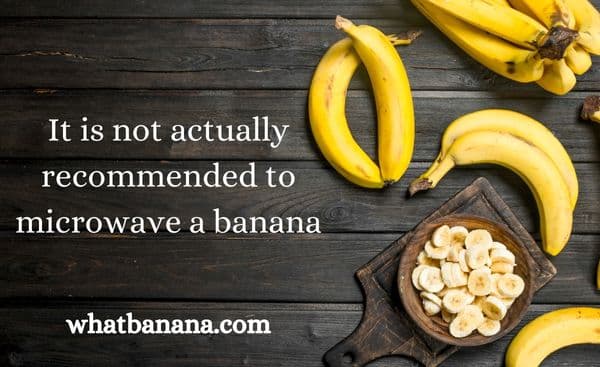Have you ever fancied warming up your tasty fruit snack and wondered what happens if you microwave a banana?
I am sure we have all seen amusing or worrying YouTube videos where people try and microwave items that are not suitable.
Inevitably, there is some kind of explosion!
Will the same thing happen with a banana?
And does it matter whether it is peeled or not?
Let’s take a look at some of the fascinating facts about microwaving bananas.
It is not actually recommended to microwave a banana. Bananas contain potassium which is a mineral, and the waves will bounce off the fruit and may cause sparks. There have been reports that the stalk end of the banana can catch fire, but this is a rare occurrence. The fruit itself is unlikely to explode, but it can start to disintegrate, creating an unpleasant mess. However, for the purpose of ripening the banana, it can be microwaved for no more than 30 seconds. The peel will need to be pierced with a sharp knife first to allow moisture to escape.
1. Why Shouldn’t You Microwave a Banana?
Bananas contain numerous minerals and vitamins, which are undoubtedly good for you but don’t react well in a microwave.
To understand why let’s see how microwaves work.
Microwaves are actually a form of energy and cook food by radiation heating.
However, microwaves will bounce off any metal or minerals.
So, placing food in a metal dish is not recommended, nor trying to microwave any food that has traces of metal or minerals in it.
Potassium, in particular, is the main culprit in bananas, causing sparks whenever microwaves hit them.
There is always the possibility that the woody stalk end of the banana could catch fire.
Realistically, this is unlikely to happen, but always keep an eye on the microwave, and don’t leave it unattended.
Don’t be tempted to wrap the stalk in aluminum foil to protect it, as this, too, should not be put in a microwave.
A further danger is that bananas emit ethylene gas as they ripen, and this is flammable.
The gas could be ignited by the waves, causing a fire.
The one exception to all these scare-mongering stories is that you can thaw frozen bananas in the microwave.
They can be safely left on the defrost setting for up to four minutes.
They will become extremely slushy, so make sure you put them in a suitable container so as not to leak all over the microwave.

2. Can You Ripen a Banana in the Microwave?
In the truest meaning of the word ripen, it is not possible to speed up the process.
For example, a green banana cannot be ripened in the microwave.
However, a slightly underripe banana will become softer in the microwave.
Unlike natural ripening, the flesh of the banana will not become sweeter, just softer.
The recommended maximum of 30 seconds should not be exceeded.
Make sure you pierce the skin of the banana in several places to allow moisture to escape.
Or use a peeled banana instead.
You may see a pool of sticky liquid form under the fruit, but this is harmless.
Allow the banana to cool slightly before checking the softness, as it will be very hot.
If the sugars have started to caramelize, they can cause a nasty burn to the skin.
The banana will likely have become too soft to pick up and will be more suitable for cooking.
Can I Ripen a Banana in the Microwave?
Final Thoughts
Now we have discovered what happens if you microwave a banana.
It’s really not recommended, as the minerals within the fruit can cause sparks.
There is also the possibility of fire, particularly due to the woody stalk of the banana.
The only exception is using the microwave to defrost frozen bananas.
A microwave can be used to make a banana softer, but it won’t be any sweeter as in traditional methods of ripening.
Better safe than sorry; keep your bananas away from your microwave!
If this has “sparked” your interest (see what I did there!), then you might also enjoy finding out if bananas are capable of conducting electricity.

We microwaved a banana and sure enough the stalk caught fire. It can happen!